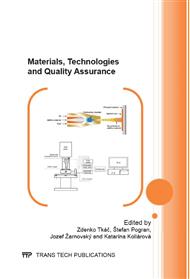p.81
p.87
p.95
p.103
p.109
p.117
p.123
p.131
p.137
Effectiveness of Hard Turning
Abstract:
Hard turning is a turning operation performed on hard materials (hardness more than 45 HRC) in order to reach surface roughness close to that obtained in grinding. The development of this technology was accompanied by the development of new cutting materials such as cutting ceramics, cubic boron nitride and polycrystalline diamond. Especially cubic boron nitride has found its use in hard part turning operations because of its characteristics. However, new cutting materials result in new questions, which researchers are trying to solve. The major consideration for a user of this relatively new technology is the quality of parts produced and how the new cutting material will behave during machining. This paper aims to document and describe the process of wear on the cutting edge of a tool made from cubic boron nitride of a different grade and with a different geometry of the cutting edge, and its influence on surface roughness and quality. Wear was documented by a digital microscope with measurement option. Surface roughness was measured by a roughness meter. A notable observation from this research is that the flank wear of the cutting tool has a large impact on the quality of machined parts (especially surface finish and surface integrity) [1].
Info:
Periodical:
Pages:
109-116
Citation:
Online since:
September 2013
Authors:
Price:
Сopyright:
© 2013 Trans Tech Publications Ltd. All Rights Reserved
Share:
Citation:


